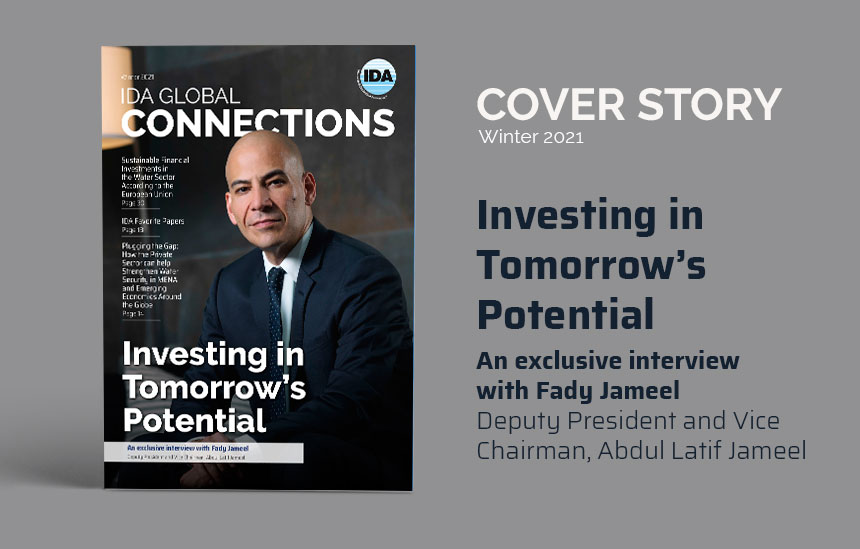Published on IDRA Global Connections Winter 2021 Issue
- An exclusive interview with Fady Jameel Deputy President and Vice Chairman, Abdul Latif Jameel
“Water is a key, if not the key, critical issue both for the planet and humankind. Innovating, developing and investing in processes and technologies that enable us, as a society, to provide an adequate supply of water for our communities, industries and agriculture – in a way that doesn’t harm, but is in harmony with the environment – is one of the biggest challenges we will ever face.”
– Fady Jameel
How engaged are you personally with the water industry?
I have a deep personal concern for the environment and our planet and strongly believe in how energy and water projects and new technologies can help us meet what are some of our greatest challenges. I’d like to consider myself what you might call an ‘activist-investor’ – championing initiatives, whether philanthropic or commercial, that are able to make a real, tangible and meaningful contribution to building a better world. Of course, I acknowledge that everyone of us, including myself, and Abdul Latif Jameel, need to do more to help achieve that goal, but we are starting to take meaningful steps towards that.
I strongly believe the issues around water scarcity are simply too big to ignore. The climate crisis we have seen accelerating in recent years is driving increasing and unsustainable pressure on fresh water, the most precious of our planet’s resources. Extreme weather phenomena are
increasing in frequency: drought, floods, glacial melting, famine, and wildfires. If we concentrate only on addressing these ‘symptoms’ rather than engineering fundamental change in our relationship with water and its central role in the planet’s environmental wellbeing, this will not only
continue, it will worsen considerably.
As you rightly point out, the growing demand for water puts increasing pressure on the limited resources available. How can this best be addressed?
Desalination and wastewater treatment are probably the most advanced currently available technologies that are able to play an important role in overcoming the water sustainability challenge. Globally, more than 300 million people already get their water from desalination plants.
At the same time, innovation, policy and social acceptance around wastewater reuse has been gaining momentum. Global contracted reuse capacity has almost doubled since 2010 and I expect the pace of growth to continue, if not increase. A few pathfinders are leading the way here such as California and Singapore. This trend will be further strengthened by EU and US wastewater re-use regulations, which help to provide a consistent international framework and raise public awareness of the benefits and standards around water reuse.
The direction of travel is clear, and I expect to see a lot more innovation and investment activity in both the desalination and wastewater treatment sectors in the coming years, as two of the most promising solutions to the water scarcity challenge.
One of the main factors holding back investment in water technologies, historically, has been the institutional capacity, and specifically the cost of energy required to run desalination and wastewater treatment plants effectively. How is this changing?
It is undoubtedly a cruel irony that desalination is often uneconomical in areas that need it most. In addition to the significant energy costs, water is heavy and expensive to transport. This means desalination plants are typically located on the coast and near the point of use, serving
relatively affluent industrial, commercial, or domestic demand, and leaving more deprived, inland areas literally ‘high and dry’. More and more, with the advancement of renewable energy sources, we are seeing small remote desalination units implemented to serve off-grid communities.
“The direction of travel is clear, and I expect to see a lot more innovation and investment activity in both the desalination and wastewater treatment sectors in the coming years, as two of the most promising solutions to the water scarcity challenge”
Thankfully, costs are expected to decline by up to two-thirds over the next two decades. Extensive research into pretreatment, nano-technology filtering, and electrochemical methods promises to make desalination even more efficient, while a new generation of ‘greener’ facilities are
already making desalination an ever-more sustainable solution. We also see renewable energy as a vital piece of the jigsaw when it comes to achieving the full potential of affordable desalination and wastewater treatment technologies. That’s why we have embedded it in our long-term
philosophy at Abdul Latif Jameel.
Prof. John H. Lienhard V, who is a member of the Board of IDRA and appointed Dean of the IDRA Academy Program, is also the Director of the Abdul Latif Jameel Water and Food Systems Lab (J-WAFS) at MIT. Community Jameel has made a profound financial investment in the Lab, can you tell us about the lab and its work?
J-WAFS is one of four research labs we cofounded or fund at MIT through Community Jameel, an international organization founded by my father, Mohammed Jameel, that uses evidence, science, data and technology to tackle urgent global issues. The others are the Abdul Latif Jameel Poverty Action Lab (J-PAL), the Abdul Latif Jameel World Education Lab (J-WEL), and the Abdul Latif Jameel Clinic for Machine
Learning in Health (the Jameel Clinic).
J-WAFS brings together some of the world’s leading researchers in water and food systems to help combat the unprecedented challenges of climate change.
When MIT and Community Jameel cofounded J-WAFS in 2014, we already recognized the impending water and food emergency and the crisis facing our society. The idea behind the lab is to facilitate and encourage the cross-fertilization of ideas and develop breakthrough research and
technology that can then be commercialized in the real world, particularly in less developed markets. Community Jameel itself acts as a bridge between leading edge research on the one hand, and potential investors and partners on the other, leveraging the long-standing links between
the Jameel family and MIT.
How does the MIT Abdul Latif Jameel Poverty Action Lab (J-PAL) address and impact water policy reform and development?
J-PAL is a global research center working to reduce poverty (and tackle other issues) by ensuring that policy is informed by scientific evidence. Anchored by a network of over 190 affiliated professors around the world – and led by its Nobel prize winning cofounders, professors Abhijit Banerjee and Esther Duflo – J-PAL conducts randomized impact evaluations to assess policy impact. The lab supports evidenced based policy
development by encouraging policymakers to apply understanding from their assessments. J-PAL also provides insights that explain the general lessons emerging from the research and condenses the results from evaluations in policy publications and evaluation summaries, making this invaluable data accessible to the widest possible audience. Most recently, J-PAL and King Philanthropies launched the King
Climate Action Initiative to design, test, and scale solutions at the nexus of climate change and poverty.
How optimistic are you for the future of the water industry and its wider role in shaping our response to the climate crisis?
I’m an optimist by nature, so I’m hopeful we can take the necessary steps to deliver on the potential of the water industry to sustain our communities, protect our planet and safeguard our future.
The water crisis is everyone’s responsibility.
And I firmly believe that if we prioritize the water challenge, establish the policy and fiscal frameworks to encourage investment, management, and innovation, and foster a spirit of collaboration and partnership, we can build a water industry with the capacity and commitment to play a critical role in strengthening water security and global development.




